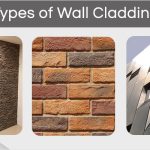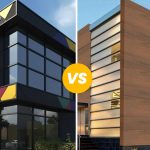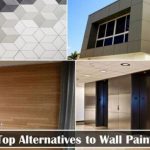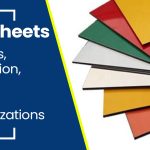In the world of contemporary architecture, metal cladding reigns supreme as the go-to choice for creating awe-inspiring facades. This dynamic fusion of form and function has transformed buildings into striking works of art that withstand the test of time. It is a popular architectural and construction technique that enhances the appearance, durability, and weather resistance of buildings.
Post your Requirement
Whether you’re a design enthusiast, a construction professional, or simply curious about modern building techniques, this blog will provide valuable insights into the art of metal cladding. Let’s embark on a riveting journey into the captivating world of metal cladding, exploring its various types, applications, and processes involved, where need meets durability and innovation harmonizes with tradition.
What is metal cladding?
Wall cladding systems while enhancing the aesthetic of a building also adds a series of added benefits including but not limited to fire resistance, resistance to moisture, better acoustics, environmental concerns while addressing and adhering to several other technical specifications. When looking for a modern, cost-effective and top-notch environmentally friendly wall cladding, metal wall cladding is the numero uno choice. Metal panels can be seamlessly fit over any kind of cladding or even existing metal systems with relative ease.
Metal Wall cladding helps adds another dimension to your home or your office structure and is extremely easy to maintain as well. Being lightweight and durable, the possibilities of cladding profiles are far and numerous; it can make your mundane and dull exteriors walls, beautiful and long lasting or even liven up your interiors as highlight wall on the inside while resisting chipping, flaking and blistering. Metal cladding helps add depth and texture and it’s available in several types of metals, colours, and can be further customized to cater to your exact needs and requirements.
Weather tight and secure, it will stand the test of time and is the right choice for protecting your interior and exterior walls. Besides, metal cladding is energy efficient which not only helps reduce your carbon imprint but also help reduce your monthly heating and cooling bills. Furthermore, Metal is also recyclable thus helping reduce your overall impact on the environment as well.
Suggested Read: Different Types of Cladding Material
Types Of Metal Cladding
Metal cladding is extremely sturdy and durable and has a very long lifespan depending on the metal cladding types. Walls can be finished with a wide array of metals and techniques which provide excellent resistance and coverage against weather conditions while being completely resistant to abrasions, UV rays and staining.
Today, Metal wall cladding is one of the most preferred cladding materials for newer homes. They not only improve the value and appearance of your interiors or exteriors but are also lightweight, fireproof and waterproof whilst also providing excellent acoustic performance.
Types of metal cladding range for interior and exterior cladding are:
Zinc Cladding:
Zinc cladding refers to the application of zinc sheets or panels on the exterior of buildings to create a protective and visually appealing surface. Zinc cladding is known for its distinct matte-gray patina that develops over time, giving buildings a unique and weathered appearance. It is valued for its durability, corrosion resistance, and low maintenance requirements. Zinc cladding is commonly used in contemporary architecture due to its versatility, lightweight nature, and ability to adapt to various design styles.
Galvanised steel Cladding:
Galvanized steel cladding involves coating steel with a layer of zinc to protect it from rust and corrosion. The galvanization process involves immersing the steel in molten zinc, forming a metallurgical bond that provides excellent weather resistance and durability. Galvanized steel cladding is widely used in industrial and commercial buildings due to its cost-effectiveness, longevity, and robustness. It is available in various finishes, ranging from shiny and reflective to matte gray appearance.
Aluminium Cladding:
Aluminum cladding involves using aluminum sheets or panels to cover building exteriors. Aluminum is prized for its lightweight nature, making it easy to install and transport. It offers exceptional corrosion resistance, making it suitable for various climates. Aluminum cladding comes in an array of colors and finishes, making it a popular choice for contemporary architectural designs. It is widely used in both residential and commercial construction for its aesthetic appeal, versatility, and ease of maintenance.
Brass Cladding:
Brass cladding entails using brass sheets or panels to adorn building facades. Brass is an alloy of copper and zinc, and it’s warm golden hue adds a touch of elegance and sophistication to structures. Brass cladding is primarily chosen for its aesthetic appeal and ability to create a timeless, classic look. However, it may require periodic maintenance to retain its luster, as it tends to develop a patina over time due to exposure to the elements.
Bronze Cladding:
Bronze cladding involves applying bronze sheets or panels to the exterior of buildings. Bronze is an alloy of copper and tin, which gives it a rich, reddish-brown color. Bronze cladding is known for its unique visual appeal, as it ages gracefully and develops a distinctive patina that varies with exposure to the environment. This material is favored for its durability, weather resistance, and ability to add a touch of luxury to architectural designs.
Titanium Cladding:
Titanium cladding refers to the use of titanium sheets or panels to cover building exteriors. Titanium is renowned for its exceptional strength-to-weight ratio, making it a lightweight yet robust cladding material. Titanium cladding offers excellent corrosion resistance, making it suitable for coastal or high-moisture environments. It is known for its modern and sleek appearance, making it a popular choice for contemporary and futuristic architectural styles. Titanium cladding is often used in high-end projects where design and performance are paramount.
Cooper Cladding
Manufacturing Process of Metal Cladding
The manufacturing process of metal cladding involves several key steps, from material selection to installation. The specific process may vary depending on the type of metal cladding being used and the desired end product. Here is a general overview of the typical manufacturing process for metal cladding:
Suggested Read: Different applications of Wall Cladding
Material Selection:
The first step is to select the appropriate metal material for cladding. Common metals used in cladding include aluminum, zinc, copper, stainless steel, brass, bronze, and others. The choice of material is influenced by factors such as aesthetics, weather resistance, cost, and building requirements.
Surface Preparation:
Before the cladding material is applied, the building’s surface needs to be prepared. This involves cleaning the surface to remove any dust, dirt, or contaminants that could affect the adhesion of the cladding. Surface preparation is crucial to ensuring a strong bond between the metal and the building substrate.
Cutting and Shaping:
Once the metal material is selected and the surface is prepared, the metal sheets or panels are cut and shaped to the required dimensions. Various cutting methods, such as shearing, sawing, or laser cutting, may be employed to achieve the desired shape and size of the cladding pieces.
Coating and Finishing:
In some cases, the metal cladding may undergo additional coatings or finishing treatments to enhance its performance and appearance. For example, metals like steel may be galvanized to improve corrosion resistance, and aluminum may be anodized for added protection and color options. Finishing processes, such as polishing, brushing, or painting, may also be applied to achieve specific visual effects.
Attachment System Design:
An essential aspect of metal cladding manufacturing is designing the attachment system that will secure the metal panels to the building’s structure. The attachment system needs to provide a secure and durable connection while allowing for the natural expansion and contraction of the metal due to temperature changes.
Fabrication and Assembly:
Once the metal panels are cut, shaped, coated, and finished, they are assembled according to the architectural design and attachment system. This step involves carefully positioning and aligning the metal panels to ensure a seamless and aesthetically pleasing appearance.
Quality Control:
Throughout the manufacturing process, rigorous quality control measures are implemented to ensure that the metal cladding meets the required standards. This includes checking for dimensional accuracy, surface finish, and coating integrity.
Installation:
After the metal cladding is manufactured and passes quality control checks, it is transported to the construction site for installation. Qualified technicians or contractors carefully install the metal cladding panels, following the designed attachment system and manufacturer’s guidelines.
Maintenance and Longevity:
Once installed, metal cladding requires regular maintenance to preserve its appearance and performance over time. Depending on the material used, periodic cleaning, inspection, and touch-ups may be necessary to ensure the cladding’s longevity and continued protection of the building envelope.
Conclusion
Metal cladding is a captivating fusion of form and function that has revolutionized modern architecture. The manufacturing process ensures durability, weather resistance, and adaptability to various design styles. It not only enhances aesthetics but also strengthens buildings against the elements, making it a practical and enduring choice. With the hands of skilled craftsmen and the vision of creative minds, metal cladding stands as an art form, leaving an indelible mark on architectural landscapes. As innovation continues to drive the industry forward, metal cladding will remain at the forefront of progressive design, shaping a bold and beautiful future for architecture.



















Post A Comment